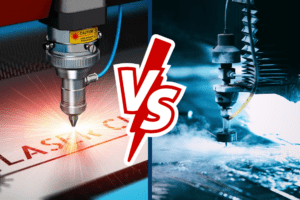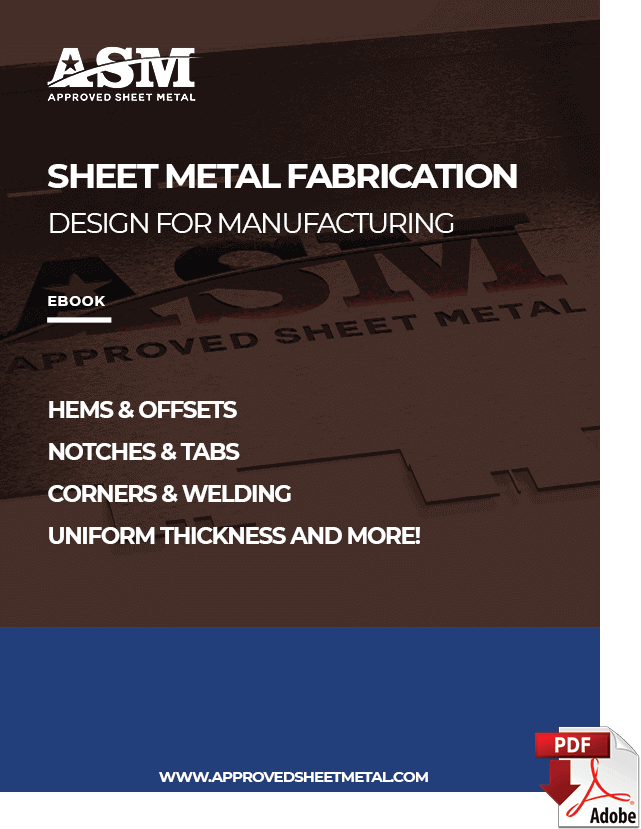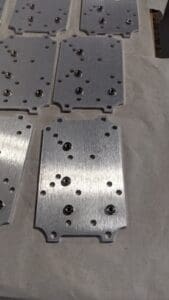Last updated on February 6th, 2025 at 09:07 am
In the ever-evolving sheet metal fabrication landscape, two cutting technologies are currently recognized as the top solutions for a multitude of projects: Laser Cutting vs. Waterjet Cutting for Sheet Metal Fabrication.
Each cutting method has advantages and disadvantages that should be taken into consideration before deciding on the approach to a specific project.
While Approved Sheet Metal (ASM) specializes in laser cutting, we also have the know-how to guide you toward the best cutting method for your specific project. Here, we’ll help you make sense of the two technologies and identify the best solution for your part and application.
Table of Contents
- 1 Waterjet Cutting: What It Is and When to Use It
- 2 Design Optimization Tips Breakdown for Laser Cutting & Waterjet Cutting
- 2.1 1. Optimize for Material Thickness & Cutting Method
- 2.2 2. Adjust for Cutting Tolerances
- 2.3 3. Minimize Heat-Affected Zone (HAZ) Issues in Laser Cutting
- 2.4 4. Reduce Material Waste & Cutting Time
- 2.5 5. Use Tab-and-Slot Designs for Easier Assembly
- 2.6 6. Account for Edge Quality & Post-Processing
- 2.7 7. Test Your Design with Prototyping
- 3 Sheet Metal Design for Manufacturing
- 4 Laser Cutting vs. Waterjet Cutting FAQ
- 4.0.1 What is the difference between laser cutting and waterjet cutting for sheet metal fabrication?
- 4.0.2 What are the advantages and disadvantages of waterjet cutting?
- 4.0.3 What are the key advantages and disadvantages of laser cutting?
- 4.0.4 What factors should I consider when choosing between laser cutting and waterjet cutting for my project?
- 4.0.5 How does ASM help in selecting the appropriate cutting technology for my project?
Waterjet Cutting: What It Is and When to Use It
Also called “waterjetting,” waterjet cutting employs a fast, dense, high-pressure stream of water to slice through sheet metal and other materials. Infused with abrasives such as garnet or aluminum oxide, the liquid is projected through a small-bore nozzle with impressive power that can even cut ceramics, tempered glass, and diamonds.
Pros and cons of waterjet cutting
Waterjetting is incredibly versatile, capable of cutting a wide range of material types and thicknesses. Though less expensive than laser cutting, waterjet cutting isn’t as smooth as laser cutting and can produce jagged edges.
Laser Cutting: What It Is and When to Use It
Our sheet metal shop’s in-house fiber optic laser cutter is designed expressly for metalwork, with a beam generated by a fiber optic cable and amplified through a focal lens to perform clean, precise cuts.
Pros and cons of laser cutting
Fiber optic laser cutting is faster and more precise than waterjet cutting. The laser also has the ability to etch and engrave metals, replicating complex designs or performing simple part marking. Laser cutting is, however, a pricier option than waterjetting, so we advise customers to consider the overall scope and purpose of their project before requesting this option.
Laser or Waterjet: 4 Top Considerations
In sheet metal manufacturing, the choice between laser cutting and waterjet cutting might be made for you—simply because of your material type or accuracy requirements. Here are four examples of the factors that determine which process will serve your needs:
Material thickness
Our sheet metal shop’s laser can cut metals up to 0.375” (⅜”) thick with high precision for even tight tolerances. A waterjet cutter is capable of cutting through thicker materials, but you won’t be able to achieve the same level of accuracy and precision possible with a laser. If you need excellent precision on parts that are too thick for laser cutting, your part will require machining.
Heat
Waterjet cutting is a cold process that doesn’t produce heat, which is advantageous for a couple of key reasons. First, a heat-free process means your material’s physical properties are unaffected. Second, fabricators can move a waterjet-cut piece from the waterjet machine directly to the next process without having to remove any heat-affected material.
You should note that while waterjet cutting cannot heat damage a part, the technique places extremely high forces on the material. This pressure can deform very thin materials and small parts and may render the machine incapable of cutting intricate features.
Laser cutting does, of course, generate heat. The laser’s heat becomes a concern when cutting thinner metals, which can deform under high heat, as well as intricate features and perforated patterns, which are especially sensitive to heat deformation and rolling.
In some cases, our sheet metal shop can mitigate those issues with our laser’s water assist feature. Another solution is to combine laser cutting with a punch tool, which allows ASM to alternately apply cutting or punching to different features, minimizing the impact of the laser’s heat.
Accuracy and precision
The quality differences between laser cutting and waterjet cutting are visible to the naked eye. If your part won’t be visible in its application and doesn’t require tight tolerances, waterjetting may be perfectly acceptable.
ASM’s laser cutter, however, is more accurate than a waterjet machine and ideal for precision sheet metal parts with tighter tolerances. Even with the smallest waterjet width of 0.020”, the cutting tolerance of a waterjet cutter is 0.008”. Laser beam widths are dynamic and can shrink to a very narrow 0.001”, achieving a cutting tolerance of approximately 0.002”.
Speed
Individual machines offer varying levels of power, but as a rule, lasers are faster cutters than waterjet machines. Laser cutters typically cut anywhere from 20-1000” per minute depending on the material type and thickness, while a waterjet cutter will only achieve between 1-20” per minute.
The Right Cutting Technology for Your Application
In comparing laser cutting and waterjet cutting, there’s no overall winner. The “best” method is always whichever one delivers the best results for your particular part and project.
ASM’s sheet metal shop provides laser cutting in-house, or we can call on our waterjetting partner to provide waterjet cutting services. Our goal is always to deliver superior sheet metal manufacturing that meets every requirement.
Design Optimization Tips Breakdown for Laser Cutting & Waterjet Cutting
Choosing the right cutting method is just one part of achieving an efficient and cost-effective sheet metal part. Optimizing your design for the chosen cutting process can reduce costs, improve accuracy, and streamline production. Here are some key design considerations:
1. Optimize for Material Thickness & Cutting Method
- Laser Cutting: Best for sheet metal up to 0.375” (⅜”) thick with precise features. For thicker metals, consider a different approach or ensure your design accounts for laser kerf width.
- Waterjet Cutting: Suitable for thicker materials, but it’s slower and less precise than lasers. Ensure your design allows for edge finishing if needed.
2. Adjust for Cutting Tolerances
- Laser Cutting: Extremely precise, with tolerances as tight as ±0.002”. If working with intricate designs, use kerf compensation to ensure accuracy.
- Waterjet Cutting: Tolerances range from ±0.008” to ±0.020”. Avoid extremely small or delicate features, as the high-pressure water can deform the material.
3. Minimize Heat-Affected Zone (HAZ) Issues in Laser Cutting
- If your design includes small holes, fine details, or perforations, adjust placement to prevent distortion from laser heat.
- Consider alternating laser cutting with punching (if applicable) to reduce the impact of heat on intricate features.
4. Reduce Material Waste & Cutting Time
- Nesting parts efficiently on a single sheet minimizes scrap and reduces costs. ASM can assist with custom nesting strategies.
- For waterjet cutting, minimize unnecessary cuts—more complex paths slow production and increase cost.
5. Use Tab-and-Slot Designs for Easier Assembly
- Laser cutting allows for precision-cut interlocking features like tab-and-slot joints.
- This can eliminate the need for welding or additional fasteners, speeding up assembly and reducing costs.
6. Account for Edge Quality & Post-Processing
- Laser Cutting: Produces smooth edges, reducing the need for secondary finishing.
- Waterjet Cutting: May leave rougher edges due to the abrasive process—plan for deburring or secondary machining if needed.
7. Test Your Design with Prototyping
Before committing to full production, consider creating a prototype using ASM’s laser cutting capabilities. This allows for design refinements and ensures that features like hole size, bend reliefs, and cut tolerances meet your functional requirements.
Request a secure quote to kickstart your next project!





